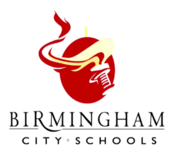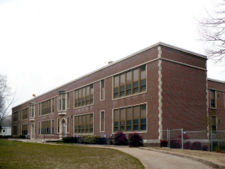Birmingham City Schools
Birmingham City Schools is the public school system for the City of Birmingham, administrated by the Birmingham Board of Education. The system currently operates 65 schools, but is actively combining and closing underutilized facilities as enrollment has dropped. Official enrollment for 2007 is 28,393 students, down from 29,736 at the same time in 2006. The acting Superintendent of Schools, since February 2008, is Barbara Allen, who is serving while Stan Mims remains on leave.
History
Founding
Birmingham's first public school was the Free School established in 1874 under the leadership of John T. Terry and James Powell. Despite its name, the trustees found it necessary to charge a nominal fee to students for a number of years in order to meet their budgets. That school, renamed "Powell School" became a high school when the next school were constructed in 1883. John H. Phillips became superintendent of schools that year and, two years later, oversaw the formation of the first Birmingham Board of Education, taking responsibility for schools out of the direct purview of the Mayor and Board of Aldermen.
Growth
By the 1920s the need for new schools was dire. A 1923 study recommended a city-wide network of neighborhood schools. The city approved a major bond issue and Superintendent Charles Glenn and board chairman Erskine Ramsay charted a building campaign which replaced existing frame structures and temporary rented facilities with massive red-brick school buildings, many of which were designed by noted architects David O. Whillden and Warren, Knight & Davis. As the growth of the "Magic City" continued through the decade, the building program was expanded to try to keep pace. A second 1927 study led to another bond issue and more new schools. By then, Birmingham's segregation laws had been enacted, creating numerous discrete neighborhoods that soon had their own schools.
In 1952 an assessment of Birmingham's school resources found that 95% of children residing in the city attended one of the the 70 schools in the system. The study suggested several new schools be built to accommodate the "baby boom" generation. By 1961 forty-one new buildings had been completed, including several new neighborhood schools as well as auditoria or gymnasiums at existing schools.
Consolidation
The city school system has declined in enrollment since the 1970s when 60,000 to 70,000 students filled the halls. In Fall 2004 the system lost more than 2,000 students from the year previous, then another 1,565 in 2005, 1,080 in 2006 and 1,343 for 2007. The number of students determines, in large part, the amount of state funding given to the system.
Superintendent Mims initially said that approximately 10 schools will be recommended for closure before the Fall 2007 school year. In April 2007 it was proposed that L. Frazier Banks Middle School, Curry Elementary School and Kennedy Alternative School would close, along with the McCaw School for students with severe behavioral problems and the Eureka Center, housing the system's Family Literacy Center. Banks closed in December 2006 while Curry and Kennedy were closed during the summer of 2007. Mims said that he would wait until after Labor Day 2007 to make recommendations for further school closures.
In January 2008 Mims presented a revised school-reorganization plan to the board. Under that proposal a total of 18 schools would close over the following four years. Among the changes to the plan, Glenn Middle School and Norwood and Gibson Elementary Schools would remain open while Wilson Elementary School and Putnam and Center Street middle schools would close. Ramsay High School would be converted into a magnet middle school while an expanded Parker High School would accommodate students from Ramsay.
In February 2008 Mims was placed on leave and Barbara Allen took over as acting superintendent. She held further public meetings and then presented a consolidation plan to the board which was approved on February 26. Under the approved plan, Hayes and West End High Schools would close in the summer of 2008 along with Kingston K-8 School, McElwain, and Oliver Elementary Schools. In 2009 Kirby Middle School would close while a new Hudson K-8 School was created and Norwood Elementary School expanded to K-8. In 2010 Wilson, North Birmingham and Gibson Elementary Schools would close while a new K-8 school opened at the Hayes High School site. In 2011 Hill, Going, Arthur, Price, Powderly and Wenonah Elementary Schools would close, along with A. G. Gaston K-8 School. Meanwhile, new schools would be created in Oxmoor Valley, Wylam, and Jones Valley.
Recent construction
Despite the drop in enrollment and a shortage of revenues for school operations, the system has significant resources for capital projects. Based on its 2004 enrollment, Birmingham City Schools were given a $331 million share of the Jefferson County School Construction Fund, a $1.1 billion bond issue financed by a county-wide sales tax increase. The Board voted on January 23, 2007 to contract with Volkert & Associates of Mobile to oversee construction management for all capital projects planned using those funds.
Schools
The Birmingham School district is currently composed of 65 schools, divided into 9 districts and 5 clusters.
Current schools
Former schools
Former schools in the Birmingham School System include Apple Valley School, Banks High School, Calloway School, Eureka School, Fairmont School, Graymont School, Lakeview School, Lane School, McCaw School, Phillips High School, Powell School, Sandusky School, Sherman Heights School, Stockham Valve School, Scott School, Sherman Heights School, Spauldin Elementary School, Thomas School, Ullman School, and West Center Street School.
References
- Dillon, Elsie H. (1972) A Brief History of Birmingham Public Schools, Centennial Edition, 1883-1972.
- Report of Progress on Birmingham City Schools, 1921-1931
- Birmingham Historical Society (February 2008) "Cataloguing School Closures." Birmingham Historical Society Newsletter.
- Hickerson, Patrick (July 28, 2006) "Pupil loss may cost schools $3 million". Birmingham News
- Leech, Marie (January 24, 2007) "Board extends Volkert contract for construction management." Birmingham News
- Leech, Marie (April 24, 2007) "Birmingham school board OKs closing buildings, may fire 176 on Monday." Birmingham News
- Leech, Marie (August 22, 2007) "System loses 1,000-plus students." Birmingham News
- Nance, Rahkia (November 1, 2007) "City schools lose students; slight changes in other areas." Birmingham News
- Leech, Marie (December 24, 2007) "14 buildings for sale in '08." Birmingham News
- Leech, Marie (January 31, 2008) "Birmingham city school closing plan changes for third time." Birmingham News
- Leech, Marie (February 27, 2008) "Birmingham Board of Education approves plan to close 16 schools, narrowly avoids state takeover." Birmingham News
External links
- Birmingham City Schools website
- Map of Birmingham City Schools locations on maps.google.com
- List of school closures and consolidations compiled by the Birmingham News


